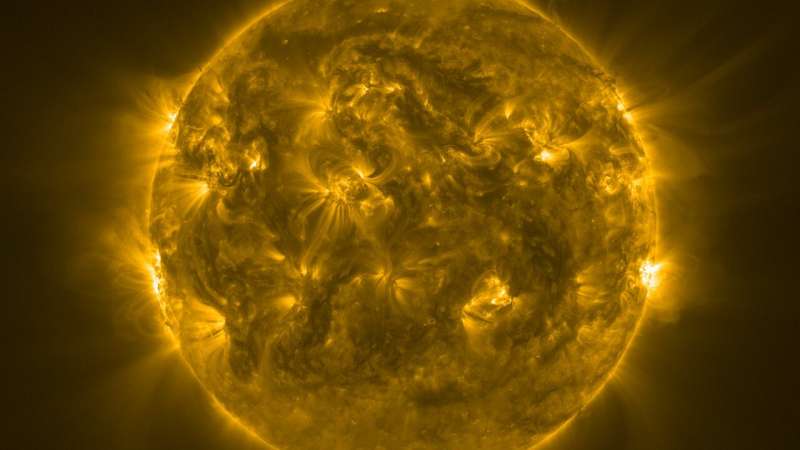This article has been reviewed according to Science X's editorial process and policies. Editors have highlighted the following attributes while ensuring the content's credibility:
fact-checked
peer-reviewed publication
trusted source
proofread
Rethinking the sun's cycles: New physical model reinforces planetary hypothesis

Researchers at the Helmholtz-Zentrum Dresden-Rossendorf (HZDR) and the University of Latvia have posited the first comprehensive physical explanation for the sun's various activity cycles. It identifies vortex-shaped currents on the sun, known as Rossby waves, as mediators between the tidal influences of Venus, Earth as well as Jupiter and the sun's magnetic activity.
The researchers therefore present a consistent model for solar cycles of different lengths—and another strong argument to support the previously controversial planetary hypothesis. The results have now been published in the journal Solar Physics.
Although the sun, being near to us, is the best researched star, many questions about its physics have not yet been completely answered. These include the rhythmic fluctuations in solar activity. The most famous of these is that, on average, the sun reaches a radiation maximum every eleven years—which experts refer to as the Schwabe cycle.
This cycle of activity occurs because the sun's magnetic field changes during this period and eventually reverses polarity. This, in itself, is not unusual for a star—if it weren't for the fact that the Schwabe cycle is remarkably stable.
The Schwabe cycle is overlaid by other, less obvious fluctuations in activity ranging from a few hundred days to several hundred years, each named after their discoverers. Although there have already been various attempts to explain these cycles and mathematical calculations, there is still no comprehensive physical model.
Planets set the beat
For some years, Dr. Frank Stefani of HZDR's Institute of Fluid Dynamics has been an advocate of the "planetary hypothesis" because it is clear that the planets' gravity exerts a tidal effect on the sun, similar to that of the moon on the Earth. This effect is strongest every 11.07 years: whenever the three planets Venus, Earth and Jupiter are aligned with the sun in a particularly striking line, comparable to a spring tide on Earth when there is a new or full moon. This coincides conspicuously with the Schwabe cycle.
The sun's magnetic field is formed by complex movements of the electrically conducting plasma inside the sun. "You can think of it like a gigantic dynamo. While this solar dynamo generates an approximately 11-year activity cycle in its own right, we think the planets' influence then intervenes in the workings of this dynamo, repeatedly giving it a little push and thus forcing the unusually stable 11.07-year rhythm on the sun," Stefani explains.
Several years ago, he and his colleagues discovered strong evidence of a clocked process of this kind in the available observation data. They were also able to correlate various solar cycles with the movement of the planets just using mathematical methods. At first, however, the correlation could not be sufficiently explained physically.
Rossby waves on the sun act as intermediaries
"We have now found the underlying physical mechanism. We know how much energy is required to synchronize the dynamo, and we know that this energy can be transferred to the sun by so-called Rossby waves. The great thing is that we can now not only explain the Schwabe cycle and longer solar cycles but also the shorter Rieger cycles that we hadn't even considered previously," says Stefani.
Rossby waves are vortex-shaped currents on the sun similar to the large-scale wave movements in the Earth's atmosphere that control high- and low-pressure systems.
The researchers calculated that the tidal forces during the spring tides of two of each of the three planets Venus, Earth and Jupiter had exactly the right properties to activate Rossby waves—an insight with many consequences.
First of all, these Rossby waves then achieve sufficiently high speeds to give the solar dynamo the necessary impetus. Second, this occurs every 118, 193 and 299 days in accordance with the Rieger cycles that have been observed on the sun. And thirdly, all additional solar cycles can be calculated on this basis.
All cycles explained by a single model
This is where mathematics comes in: The superimposition of the three short Rieger cycles automatically produces the prominent 11.07-year Schwabe cycle. And the model even predicts long-term fluctuations of the sun because the movement of the sun around the solar system's center of gravity causes a so-called beat period of 193 years on the basis of the Schwabe cycle.
This corresponds to the order of magnitude of another cycle that has been observed, the Suess-de Vries cycle.
In this context, the researchers discovered an impressive correlation between the 193-year period that had been calculated and periodic fluctuations in climate data. This is another robust argument for the planetary hypothesis because "the sharp Suess-de Vries peak at 193 years can hardly be explained without phase stability in the Schwabe cycle, which is only present in a clocked process," Stefani estimates.
Does this mean the question as to whether the sun follows the planets' beat has finally been answered? Stefani says, "We'll probably only be 100% certain when we have more data. But the arguments in favor of a process clocked by the planets are now very strong."
More information: F. Stefani et al, Rieger, Schwabe, Suess-de Vries: The Sunny Beats of Resonance, Solar Physics (2024). DOI: 10.1007/s11207-024-02295-x
Journal information: Solar Physics
Provided by Helmholtz Association of German Research Centres





















